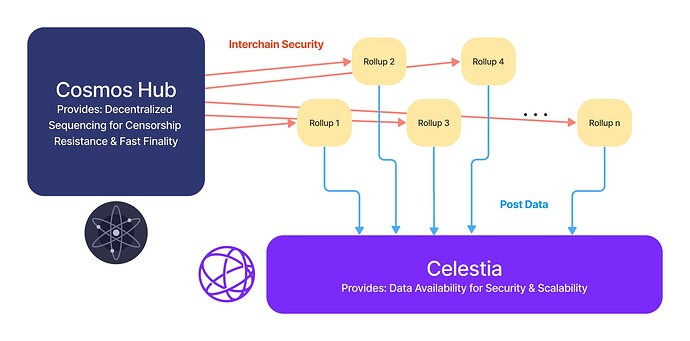TL;DR
- Launching a rollup with decentralized sequencing requires gathering a set of sequencers and issuing a new token, which is high overhead.
- Interchain security enables you to use the validator set and stake of one chain to secure new chains.
- Using interchain security, you could spin up a new rollup with decentralized sequencing by using an existing set of sequencers and stake, reducing overhead.
- Potential benefits: soft commits for fast-finality, atomic cross-rollup composability, cross-rollup MEV.
Overview
Decentralized sequencing is a common approach for rollups to achieve censorship resistance but it incurs large overhead to launch a new rollup.
I propose using interchain security to build a decentralized sequencer network as a service, which would make it possible to launch a new rollup with censorship resistance (and fast finality) with minimal overhead.
Current Problem
Decentralized sequencing requires gathering a set of sequencers and (likely) issuing a new coin to stake for leader election. Though this set of sequencers can be much smaller and the value of stake need not be as large as for an L1, this still represents significant overhead for someone seeking to launch a new rollup.
Proposed Solution
Interchain security enables one blockchain network to reuse its stake and validator set to launch and secure new chains. For example, the Cosmos hub will use its stake and validator set to launch and secure at least 5 new “consumer chains” in 2023.
This same mechanism could be to launch new rollups without needing to recruit a new set of sequencers or issue a new staking token, dramatically reducing overhead. A common sequencer network would act as “sequencers as a service”, ready to spin up new nodes for new rollups that want to launch.
These rollups still post their data to a data availability layer and use fraud or validity proofs to ensure execution validity.
Potential Benefits
- Fast Finality: This sequencer network could make slashable soft commits on new blocks to provide fast finality for better UX.
- Atomic Composability: The fact that multiple rollups share a common network of sequencers may enable mechanisms for atomic cross-rollup composability.
- Cross-Rollup MEV These sequencers would also be well positioned to apportion cross-rollup MEV.
Notes
This is still a very high-level idea and as we all know, the devil is in the details. Furthermore, I don’t know the details of how Interchain Security works.
Also note, there are other ways of providing censorship resistance for rollups like inboxes or leaderless rollups.
Feedback is much appreciated!
